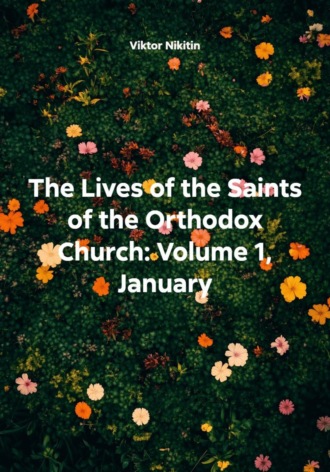
Полная версия
The Lives of the Saints of the Orthodox Church: Volume 1, January
Venerable Schema-Hierodeacon Elder Panteleimon (1884):
Elder Panteleimon was the founder of Kostychev Convent and a spiritual guide known for his humility, prayerfulness, and leadership. He revitalized monastic life in his region during the late 19th century and is remembered for his spiritual wisdom.
Righteous Euthymius (Takaishvili), Man of God, of Tbilisi (1953):
Euthymius was a Georgian scholar, historian, and righteous man who lived through Soviet oppression. Known for preserving Georgian religious culture and Orthodox faith, he is revered for his steadfastness, spiritual insight, and charitable works. He passed away in 1953, remembered as a man of prayer and national devotion.
* * *
Lives of the Saints Celebrated on January 4
Synaxis of the Holy Seventy Apostles:
The Seventy Apostles were chosen by Jesus Christ and sent out to preach the gospel as described in the Gospel of Luke (10:1-24). Unlike the Twelve Apostles, the Seventy were sent in pairs to prepare towns for Jesus’ arrival and to heal the sick. Tradition holds that many of them became bishops and missionaries, spreading Christianity widely across the Roman Empire and beyond. Their work laid the foundation for the Christian Church’s expansion and the establishment of many early Christian communities. The feast honors their missionary zeal and dedication to Christ’s message.
Martyr Djan Darada, the Ethiopian Eunuch of Queen Candace (1st century):
This saint is traditionally identified with the Ethiopian eunuch baptized by Philip the Evangelist (Acts 8:26-40). As a high official of the Queen of Ethiopia, known as Candace, Djan Darada was a man of great status. His baptism is considered one of the first recorded conversions of an African official to Christianity. After his baptism, tradition says he brought the Christian faith back to Ethiopia, contributing to the early establishment of Christianity there. He was later martyred for his faith, showing courage in the face of persecution.
Martyrs Chrysanthus and Euthymia:
Chrysanthus was a Roman nobleman who converted to Christianity. Along with his wife Euthymia, he embraced the Christian faith and renounced paganism. They faced severe persecutions under Roman authorities who sought to force them back to the old gods. Despite torture, they refused to renounce their faith and were martyred. Their story exemplifies the courage and steadfastness of early Christian couples in defending their faith together.
Martyrs Zosimas the Hermit and Athanasius the Commentarisius (Prison Warden), Anchorites of Cilicia (3rd-4th centuries):
Zosimas lived a life of solitary asceticism in the wilderness of Cilicia, practicing prayer and fasting. Athanasius was a prison guard who, upon witnessing the steadfast faith of imprisoned Christians, converted to Christianity himself. Both men embraced asceticism and openly confessed their faith, which led to their martyrdom. Their lives exemplify the transformative power of faith and the strength found in living a devoted ascetic life.
Venerable Theoprobus of Karpasia, Bishop of Karpasia in Cyprus (4th century):
Theoprobus was a bishop who shepherded the Christian community in Karpasia, Cyprus, during a time when Christianity was still gaining acceptance. He was known for his pastoral care, teaching, and defense of Christian doctrine. His leadership helped strengthen the local Church amid theological disputes and external challenges.
Righteous Apollinaria the Senator (5th century):
Born into a noble Roman senatorial family, Apollinaria renounced her wealth and high social standing to dedicate herself fully to God. She embraced asceticism, prayer, and acts of charity. Despite her aristocratic background, she sought a humble and righteous life, demonstrating that holiness is accessible regardless of social status.
Venerable Evagrius, with St. Elias the Deacon and Other Disciples of the Thirteen Syrian Fathers, of the Shio-Mgvime Monastery in Georgia (6th century):
Evagrius was one of the disciples of the Thirteen Syrian Fathers who brought monasticism to Georgia. Along with St. Elias the Deacon and others, he helped found the Shio-Mgvime Monastery, which became a major spiritual center. Their missionary efforts deeply influenced the development of Georgian Christianity and monastic tradition. They lived ascetic lives, teaching the Christian faith and guiding many in spiritual growth.
The Holy Six Martyrs:
Though their individual names are mostly lost to history, this group of six martyrs is commemorated for their courage in holding fast to the Christian faith during times of persecution. Their collective witness encouraged others and helped maintain the strength of early Christian communities.
Saint Euthymius the Younger of Thessalonica (Euthymius the New), Monk:
A Byzantine monk known for his deep asceticism and dedication to prayer, Euthymius the Younger lived a life of great holiness and was reputed for performing miracles. His teachings and example attracted disciples and pilgrims, and he was venerated as a wonderworker.
Venerable Timothy the Stylite (872):
Timothy practiced the unique ascetic discipline of living atop a pillar (stylitism). For many years, he endured harsh weather and physical hardship to devote himself fully to prayer and fasting. His extreme form of asceticism inspired many and became a notable tradition in Eastern Christian monasticism.
Saint Linus, the First Pope of Rome (ca. 76):
Linus succeeded the Apostle Peter as Bishop of Rome, becoming the first pope in the line of succession. He helped organize the early Church in Rome and guided the faithful during a time of persecution. According to tradition, he ordained priests and encouraged unity among Christians. Linus was martyred for his faith and is honored as a foundational leader of the Church.
Saint Clement I, One of the Seventy Apostles, Third Pope of Rome (ca. 101):
Clement was a direct disciple of the Apostles and became the third Bishop of Rome. He is best known for his Letter to the Corinthians, which emphasized church order and the importance of harmony and obedience. Clement was martyred under Emperor Trajan. His writings are among the earliest Christian documents outside the New Testament and helped shape early Church governance.
Saint Mavilus (Majulus), Martyr in Hadrumetum, North Africa (212):
Mavilus was a Christian living in Roman North Africa who was persecuted under Emperor Caracalla. He was thrown to wild beasts as a form of execution but survived initially through miraculous protection before ultimately dying for the faith. His martyrdom strengthened the Christian community in the region.
Martyrs Priscus, Priscillian, and Benedicta in Rome (ca. 361-363):
These martyrs suffered during the reign of Emperor Julian the Apostate, who sought to restore pagan worship in the empire and suppress Christianity. They refused to renounce their Christian faith despite torture and execution, exemplifying steadfastness in dangerous times.
Martyr Dafrosa (Affrosa), Mother of St. Bibiana (ca. 361-363):
Dafrosa was a devout Christian mother in Rome who suffered martyrdom during Julian the Apostate’s reign. She is remembered alongside her daughter Bibiana, who also became a saint. Dafrosa’s courage and faith had a lasting influence on early Roman Christians.
Martyrs Aquilinus, Geminus, Eugene, Marcian, Quintus, Theodotus, and Tryphon in North Africa (ca. 484):
These martyrs lived under the Arian Vandal king Hunneric, who persecuted Nicene Christians. Their refusal to abandon orthodox Christian belief led to imprisonment, torture, and death. Their sacrifice helped preserve orthodox faith in a region where heresy threatened the Church.
Saint Gregory of Langres, Bishop of Langres in Gaul (539-540):
Gregory was a bishop known for his holiness and numerous miracles. He served as a shepherd to the Christian faithful in Gaul during a time of transition after the fall of the Western Roman Empire, reinforcing the Church’s spiritual authority.
Saint Ferreolus of Uzes, Bishop of Uzes (581):
Ferreolus was a bishop in southern France who became known for his pastoral care, defense of Christian teaching, and charity to the poor. His leadership helped stabilize Christianity in the region.
Saint Pharaildis (Vareide, Verylde, Veerle), Patron Saint of Ghent (ca. 740):
Pharaildis was renowned for her charity and miracles, especially her care for the poor and sick in Ghent, Belgium. She is venerated as one of the city’s patron saints.
Saint Rigobert, Archbishop of Rheims and Confessor (ca. 745):
Rigobert was an archbishop recognized for his holiness, pastoral care, and opposition to heresy. He maintained Church unity and taught the faith during a turbulent time in northern France.
Venerable Theoctistus of Sicily, Abbot at Cucomo (800):
Theoctistus led a monastic community in Sicily with wisdom and holiness. He guided monks in ascetic discipline and prayer, contributing to the spiritual life of the region.
Saint Libentius (Liawizo I), Bishop of Hamburg (988-1013):
Libentius was born in Germany and became bishop of Hamburg, where he continued missionary work among pagan peoples in northern Europe, helping to Christianize the region.
Venerable Hieromartyr Abbot Euthymius and 12 Monk-Martyrs of Vatopedi Monastery, Mt. Athos (ca. 1285):
Euthymius and his twelve monks opposed the Latinizing policies of Byzantine emperors Michael Paleologos and John Bekkos. For defending Orthodoxy against attempts to unify with the Roman Catholic Church, they were martyred on Mt. Athos, a spiritual center of Eastern monasticism.
Repose of St. Eustathius I of Serbia (1286):
Eustathius was the first Archbishop of Serbia, who helped organize the Serbian Orthodox Church’s independence and spiritual growth. He was known for wisdom and holiness.
Saint Aquila, Deacon of Kiev Caves Monastery (14th century):
Aquila served faithfully as a deacon at the Kiev Pechersk Lavra, one of the most important Orthodox monasteries, known for his devotion and humble service.
Venerable Symeon of Smolensk, Metropolitan of Smolensk (1699):
Symeon was a wise and holy metropolitan who shepherded the Church in Smolensk, remembered for his leadership and pastoral care.
New Monk-Martyr Onuphrius Manassias of Gabrovo and Chilandar Monastery (1818):
Onuphrius was martyred under Ottoman oppression for refusing to abandon the Christian faith. His martyrdom is a testament to faith under persecution in the modern era.
Saint Nikiforos the Leper (1964):
Nikiforos suffered from leprosy but endured his illness with great humility and faith. He is remembered for his kindness and devotion despite his affliction.
New Hieromartyrs and Martyrs of the 20th century:
Numerous bishops, priests, monks, and laypeople suffered martyrdom under Soviet anti-religious persecutions. Their unwavering faith and courage under brutal oppression have inspired the modern Church.
Finding of the Relics of New Martyr John the Ex-Muslim of Konitsa (1974):
John of Ioannina was a former Muslim who converted to Christianity and was martyred in 1814 for his faith. His relics were discovered in 1974 at the Monastery of Prousou in Greece, renewing veneration and devotion among the faithful.
* * *
Lives of the Saints Celebrated on January 5
Prophet Micah (9th century BC):
Micah was a major prophet in the Old Testament who lived during the reigns of Kings Jotham, Ahaz, and Hezekiah of Judah. His prophecy book, “The Book of Micah,” addresses social injustices such as corruption and exploitation, condemning the wealthy for oppressing the poor. Micah is best known for foretelling the coming of the Messiah from Bethlehem (Micah 5:2), a prophecy fulfilled in the New Testament by Jesus Christ. Despite the impending judgment he warned about, Micah also spoke of hope and restoration for Israel.
Martyr Theopemptus, Bishop of Nicomedia, and Martyr Theonas, the Former Sorcerer (303):
During the fierce Diocletian persecution, Theopemptus was the bishop of Nicomedia, a key Christian center in Asia Minor. His steadfast faith and courage inspired many. Theonas, once a practicing sorcerer and magician, witnessed the miracles and holiness of Theopemptus, converted to Christianity, and renounced his former practices. Both were arrested for their refusal to worship the Roman gods. Despite harsh tortures, they remained faithful and were ultimately martyred. Their story is a powerful testimony to the transformative power of Christ’s grace and the victory of faith over superstition.
Martyr Sais:
Little specific historical information survives about Martyr Sais. However, as with many early Christian martyrs, Sais is commemorated for courageously facing persecution, refusing to renounce the Christian faith, and enduring suffering and death rather than apostasy.
Martyr Theoidus:
Theoidus, similarly, is honored for his faith and martyrdom during early Christian persecutions. His example represents the countless unnamed believers who paid the ultimate price for their faith.
Righteous Syncletica of Alexandria, Nun (ca. 350 or ca. 460):
Syncletica was a wealthy Alexandrian widow who chose the ascetic life, retreating to the desert to live in poverty and prayer. She became a spiritual mother and teacher to many other women who sought the monastic life. Her sayings, collected in the “Apophthegmata Patrum” (Sayings of the Desert Fathers and Mothers), emphasize humility, vigilance against temptation, and the love of God. She is an icon of female monasticism in early Christianity, representing strength and gentleness combined.
Venerable Domnina (Domna):
Domnina was a devout nun known for her prayerful life and ascetic practices. Her dedication to God, often in obscurity, served as an inspiration for other women seeking holiness through monasticism.
Venerable Tatiana, Nun:
Tatiana is remembered for her life in the convent marked by humility, obedience, and fervent prayer. She exemplifies the quiet strength and spiritual depth of monastic women in the early Church.
Saint Apollinaris, Virgin, of Egypt (ca. 470):
Apollinaris was an Egyptian virgin who devoted herself to God in the monastic desert tradition. Living in a community of women ascetics, she practiced fasting, prayer, and care for the poor. Her life reflects the flourishing of female monasticism in late antique Egypt.
Venerable Phosterius the Hermit (6th century):
Phosterius embraced the eremitic life, living in solitude far from worldly distractions. Known for his rigorous fasting and constant prayer, he became a spiritual guide to others seeking to deepen their relationship with God.
Saint Menas of Sinai (6th century):
Menas was a monk in the Sinai desert who lived a life of deep asceticism and spiritual warfare. His holiness drew many pilgrims and disciples, contributing to the monastic legacy of the Sinai Peninsula.
Venerable Gregory of Crete, Monk (ca. 820):
Gregory was a monk noted for his asceticism and piety on the island of Crete. He labored to maintain the purity of monastic life during a time of iconoclastic controversies and challenges.
Venerable Dorotheos the Younger, Restorer of the Ancient Monastery of the Holy Trinity at Chiliokomon in Amaseia, Pontus:
Dorotheos dedicated himself to reviving the ancient monastery in Pontus, restoring its buildings and monastic rule. His work helped rejuvenate spiritual life in the region and provided a haven for monks devoted to prayer and study.
Hieromartyr Saint Telesphorus, Greek Pope of Rome (ca. 136):
Telesphorus was an early Bishop of Rome, likely the eighth pope, who was born in Greece. He is credited with instituting the practice of fasting during Lent and emphasizing the importance of Easter celebrations. Telesphorus was martyred under Emperor Hadrian, enduring persecution for protecting the nascent Christian Church and promoting orthodoxy. He is remembered as a courageous leader who helped shape early Church liturgical practices.
Saint Emiliana, Roman Lady and Paternal Aunt of Pope St Gregory the Great (6th century):
Emiliana was a noblewoman of the Roman aristocracy known for her deep Christian piety and charitable works. She raised her family in the Christian faith, and her nephew Gregory would become one of the most influential popes and theologians of the early medieval Church. Emiliana’s nurturing of faith in her family greatly contributed to this spiritual legacy.
Saint Kiara (Chier), Spiritual Daughter of St Fintan Munnu (ca. 680):
Kiara was an Irish holy woman mentored by St Fintan Munnu, an important Irish monastic founder. She is remembered for her strict asceticism, leadership, and commitment to the monastic life during a period when Irish monasticism flourished.
Venerable Cera of Ireland (Ciar, Cyra, Cior, Ceara), Abbess (7th century):
Cera was a revered abbess in Ireland who led her monastic community with wisdom and holiness. She exemplified the role of women in preserving and nurturing Irish Christian monastic traditions during the early medieval period.
Venerable Conwoïon (Convoyon), Breton Saint and Abbot (868):
Conwoïon was a monk and abbot in Brittany who founded monasteries and promoted spiritual reform. He emphasized strict monastic discipline and was instrumental in the Christianization of Brittany, guiding monks and laity alike.
Saint Gaudentius of Gnesen (Radim Gaudentius), First Archbishop of Gnesen in Poland (1004):
Gaudentius was the first metropolitan archbishop of Poland, appointed when Christianity was officially established there. He played a crucial role in organizing the Church structure in Poland, promoting education, and spreading the Gospel among newly converted peoples.
New Monk-Martyr Romanus of Carpenision and Kapsokalyvia, at Constantinople (1694):
Romanus was a monk of Mt. Athos who suffered martyrdom under Ottoman rule. Known for his humility and spiritual strength, he refused to renounce Orthodoxy despite severe torture and was ultimately killed for his faith.
Venerable Symeon of the Pskov-Caves Monastery, Hiero-Schemamonk (1960):
Symeon was a Russian monk living in the famous Pskov-Caves Monastery. Known for his intense asceticism and deep prayer life, he was also a spiritual father to many. His life is remembered as a shining example of faithfulness under Soviet oppression.
Schema-Archimandrite Venerable Theophan (Rikhlovsky) of Nizhyn (1977):
Theophan was a Russian monastic leader and spiritual guide who lived through difficult Soviet times. His humility, wisdom, and steadfastness in prayer inspired many to remain faithful despite persecution. He is honored as a modern saint who preserved Orthodoxy in trying times.
New Hieromartyr Joseph Bespalov, and with him 37 Martyrs (1921):
Joseph Bespalov was a priest who, along with 37 others, was martyred during the early Soviet anti-Christian persecutions. Their witness includes both clergy and laity who suffered for refusing to renounce their faith or submit to atheist propaganda.
Hieromartyr Stephen Ponomarev, Protopresbyter, at Alma-Ata (1933):
Stephen was a senior priest in Kazakhstan who was executed by Soviet authorities for his dedication to pastoral ministry and refusal to abandon Orthodox Christianity.
Virgin-Martyr Eugenia Domozhirova, at Alma-Ata (1933):
Eugenia was a young woman who embraced martyrdom rather than deny her Christian faith during the Soviet anti-religious campaigns. Her purity and courage are especially remembered.
New Hieromartyr Sergius, Priest (1934):
Sergius was one of many Orthodox clergy who were persecuted and executed by the Soviet regime for maintaining religious services and ministering to the faithful.
Martyr Matthew (1938):
Matthew was a martyr of the 20th century who died for Christ under communist persecution. His life exemplifies the countless faithful who endured suffering in the modern era.
Other Commemorations:
Translation of the relics of St. Rumon, Bishop, to Tavistock Abbey: The movement of Saint Rumon’s relics to Tavistock Abbey in England was celebrated as an event bringing spiritual blessing and renewal.
Repose of Monk Alexander of Valaam Monastery (1810): Alexander was known for his deep asceticism and spiritual wisdom, living at the famed Valaam Monastery in Russia.
* * *
Lives of the Saints Celebrated on January 6
Venerable Evagrius, of Nitria (415):
Evagrius was a monk of the Egyptian desert near Nitria, renowned for his deep spiritual wisdom and writings on prayer and asceticism. He was a disciple of the great monastic leader St. Macarius the Great and contributed significantly to early Christian mystical theology. His teachings emphasize vigilance against temptation and the pursuit of purity of heart.
Venerable-martyr George the Persian (615):
George was a Persian Christian who lived under the rule of the Sassanian Empire. He endured imprisonment and torture for refusing to renounce Christianity and succumb to the Zoroastrian faith. Despite brutal trials, he remained steadfast and was ultimately martyred. George is remembered as a courageous defender of the faith under harsh persecution.
Martyrs of North-West Africa, burnt at the stake under Septimius Severus (ca. 210):
These early Christian martyrs suffered death by fire during the persecutions under Emperor Septimius Severus. Their unwavering faith and willingness to endure such a painful death symbolize the resilience of the Church in North Africa during times of severe oppression.
Virgin-martyr Macra, from Rheims in France, martyred in Fismes in Champagne, under the governor Rictiovarus (287):
Macra was a young virgin who courageously confessed her faith in Christ during Roman persecutions. Arrested and brought before the governor Rictiovarus, she refused to sacrifice to pagan gods and was executed by martyrdom in the town of Fismes.
Martyr Anastasius, a martyr in Syrmium in Pannonia, now Hungary (4th century):
Anastasius was one of the Christian martyrs in Syrmium (modern-day Sremska Mitrovica). He suffered persecution and death for his steadfast faith during the early Christian period when Roman authorities sought to suppress Christianity.
Martyrs Anastasius, Jucundus, Florus, Florianus, Peter, Ratites, Tatia and Tilis, in Syrmium in Pannonia, now Hungary (4th century):
This group of martyrs suffered together in Syrmium under Roman persecution. United in their faith, they endured torture and death rather than renounce Christ. Their collective witness strengthened the Christian community in the region.
Saint Hywyn, probably a companion of St Cadfan, by tradition he founded Aberdaron in Gwynedd (516):
Hywyn was a Welsh missionary and founder of the Christian settlement at Aberdaron, Gwynedd, Wales. He likely accompanied St. Cadfan during missionary journeys. His legacy is preserved in local traditions that honor his role in spreading Christianity in Wales.
Saint Melanius (Melaine), born in Brittany, Bishop of Rennes (ca. 535):
Melanius was born in Brittany and became bishop of Rennes. He played a vital role in combating paganism and idolatry in his diocese, promoting the Christian faith with zeal and pastoral care. Known for miracles and charity, he is revered as a holy pastor.
Saint Edeyrn (Eternus), born in Britain, hermit and patron saint of a church in Brittany (6th century):
Edeyrn was a British-born hermit who settled in Brittany. He lived an ascetic life devoted to prayer and solitude, becoming a spiritual guide and patron of a local church.
Saint Eigrad (Eugrad), brother of St. Samson, disciple of St Illtyd, founder of a church in Anglesey, Wales (6th century):
Eigrad was a Celtic saint, brother of St. Samson, and a student of St. Illtyd. He founded a church in Anglesey, Wales, contributing to the early Christianization of the region.
Saint Schotin (Scarthin), disciple of St David in Wales, hermit on Mt Mairge in Leix (County Laois) (6th century):
Schotin was a Welsh disciple of St David who lived as a hermit for many years on Mt. Mairge in Ireland. Known for his asceticism and holiness, he is venerated both in Wales and Ireland.
Saint Merinus (Mirren of Benchor), disciple of Dunawd at Bangor in Wales and venerated there and in Brittany (6th century):
Merinus was a Welsh monk trained under St. Dunawd at Bangor. He is remembered for missionary work and sanctity, with veneration extending to Brittany.









